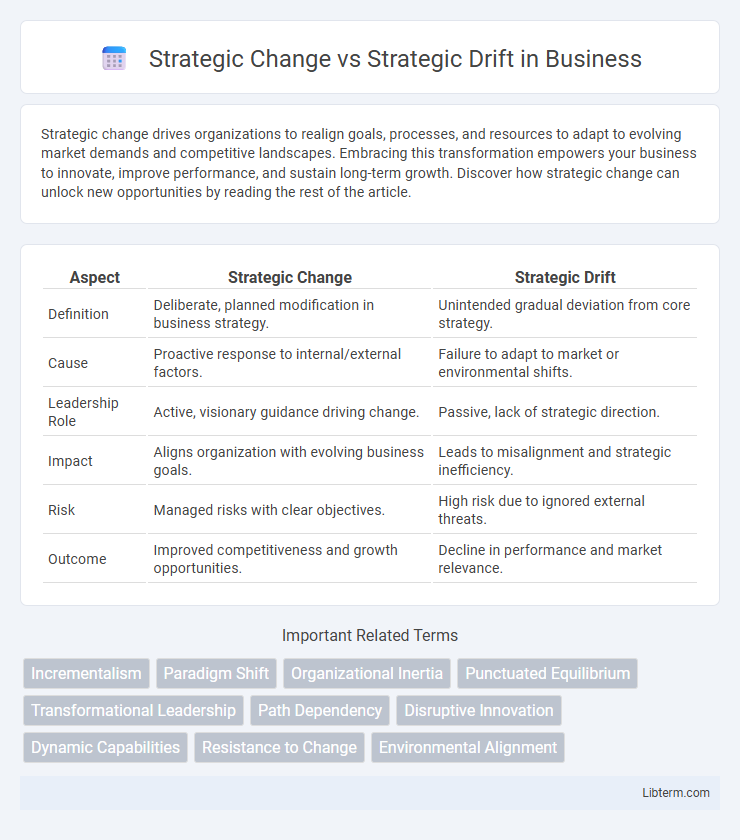Strategic change drives organizations to realign goals, processes, and resources to adapt to evolving market demands and competitive landscapes. Embracing this transformation empowers your business to innovate, improve performance, and sustain long-term growth. Discover how strategic change can unlock new opportunities by reading the rest of the article.
Table of Comparison
| Aspect | Strategic Change | Strategic Drift |
|---|---|---|
| Definition | Deliberate, planned modification in business strategy. | Unintended gradual deviation from core strategy. |
| Cause | Proactive response to internal/external factors. | Failure to adapt to market or environmental shifts. |
| Leadership Role | Active, visionary guidance driving change. | Passive, lack of strategic direction. |
| Impact | Aligns organization with evolving business goals. | Leads to misalignment and strategic inefficiency. |
| Risk | Managed risks with clear objectives. | High risk due to ignored external threats. |
| Outcome | Improved competitiveness and growth opportunities. | Decline in performance and market relevance. |
Understanding Strategic Change
Understanding strategic change involves recognizing the deliberate process organizations undertake to realign their strategies with evolving market conditions and internal capabilities, ensuring sustained competitive advantage. This proactive approach contrasts with strategic drift, where companies fail to adapt, resulting in a gradual misalignment with external environments, often leading to decline. Key elements of strategic change include leadership vision, continuous environmental scanning, and effective communication to implement transformational initiatives successfully.
Defining Strategic Drift
Strategic drift occurs when an organization gradually fails to adapt its strategy to changing external environments, leading to misalignment between its goals and market realities. This phenomenon contrasts with strategic change, which involves deliberate and proactive modifications to strategy to maintain competitiveness. Identifying strategic drift requires monitoring environmental shifts, internal capabilities, and ensuring timely strategic realignment to prevent organizational decline.
Key Differences Between Strategic Change and Drift
Strategic Change involves deliberate, planned actions by leadership to shift an organization's direction, often in response to market demands or internal goals. Strategic Drift occurs gradually and unintentionally as a company's strategy becomes misaligned with its external environment due to inertia or resistance to change. Key differences include intentionality, time frame--change is proactive and immediate, while drift is passive and slow--and the impact on organizational adaptability and competitive advantage.
Causes of Strategic Change
Strategic change occurs when organizations proactively adapt to external market shifts or internal pressures, driven by factors such as technological advancements, competitive dynamics, or evolving customer preferences. Key causes include leadership vision shifts, innovation adoption, and regulatory changes that necessitate new business models or operational processes. In contrast, strategic drift results from a failure to recognize or respond to these external and internal changes, often due to complacency, inadequate environmental scanning, or rigid organizational culture.
Causes of Strategic Drift
Strategic drift occurs when an organization fails to adapt its strategy to changing external conditions, often due to incremental changes that go unnoticed over time. Causes of strategic drift include rigid organizational culture, lack of environmental scanning, and overreliance on historical success without reassessing competitive dynamics. This misalignment between strategy and market realities can lead to deteriorating performance and eventual strategic failure.
Impact on Organizational Performance
Strategic change drives organizational performance by realigning resources, capabilities, and processes with evolving market demands, leading to enhanced competitiveness and growth. In contrast, strategic drift occurs when organizations fail to adapt their strategies to external changes, resulting in declining performance, loss of market share, and decreased employee morale. Proactive strategic change fosters resilience and long-term success, while strategic drift increases the risk of obsolescence and operational inefficiency.
Recognizing Early Signs of Strategic Drift
Recognizing early signs of strategic drift involves monitoring key indicators such as declining market share, misalignment between organizational goals and environmental changes, and diminishing competitive advantage. These symptoms often manifest as reduced customer satisfaction, slower innovation rates, and resistance to change within teams. Proactive detection through continuous strategic reviews and real-time performance metrics enables timely corrective action to prevent long-term decline.
Preventing Strategic Drift Through Effective Leadership
Effective leadership is crucial in preventing strategic drift by continuously aligning organizational goals with market dynamics and internal capabilities. Leaders must foster a culture of adaptability and clear communication to detect early signs of misalignment and respond proactively. Regular strategic reviews and stakeholder engagement enable timely adjustments, ensuring sustained competitiveness and long-term success.
Case Studies: Success and Failure Stories
Kodak's failure to adapt to digital photography exemplifies strategic drift, where slow response to market shifts led to decline, while Netflix's proactive shift from DVD rentals to streaming illustrates successful strategic change driving industry leadership. Nokia experienced strategic drift by underestimating smartphone innovation, resulting in loss of market dominance, contrasting with IBM's successful strategic change in pivoting from hardware to consulting services to regain profitability. These cases highlight the critical impact of timely strategic change versus complacency causing drift in corporate sustainability.
Best Practices for Managing Strategic Change
Effective management of strategic change requires clear vision alignment, continuous stakeholder engagement, and agile decision-making processes to adapt to emerging market trends. Implementing robust performance metrics and fostering a culture of innovation ensures that organizations avoid strategic drift, maintaining relevance and competitive advantage. Leadership commitment to transparent communication and ongoing evaluation of strategic initiatives drives successful transformation and long-term sustainability.
Strategic Change Infographic

 libterm.com
libterm.com